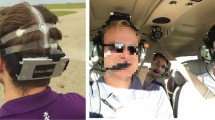Analysis of variance and discriminant analysis were used to study EEG spectral characteristics recorded using 15 leads from two professional pilots with more than 15 years of experience, in the frequency band 0.1–70 Hz, during flights on a TU-154 simulator, including takeoff, landing (including in difficult conditions), and horizontal flight. The results showed that the spectral characteristics of the EEG were highly informative measures of the ongoing functional state of the pilots at different phases of flight. The high significance of the differences seen in the individual features showed them to be nonrandom and demonstrated the potential for using EEG parameters to construct a system for monitoring the pilot’s state at all stages of flight.
Similar content being viewed by others
References
Aslanyan, E. V. and Kiroy, V. N., “Electroencephalographic evidence on the strategies of adaptation to the factors of monotony,” Span. J. Psychol., 12, No. 1, 32–45 (2009).
Aslanyan, E. V., Effects of Individual-Typological Characteristics on the Dynamics of Functional Status in Humans in Conditions of Monotonous Activity: Auth. Abstr. Mast. Thesis in Biol. Sci., Res. Inst. Neu rocybernetics, Rostov State Univ., Rostov-on-Don (2002).
Bekhtereva, N. P. and Nagornaya, Zh. V., “Dynamics of EEG coherence on performance of tasks involving nonverbal (imaginary) creativity,” Fiziol. Cheloveka, 33, No. 5, 5–13 (2007).
Boeing. Statistical Summary of Commercial Jet Airplane Accidents Worldwide Operations 1959–2010, Boeing, June 2011.
Boitsova, Yu. A. and Dan’ko, S. G., “Changes in the EEG on comparison of the resting state with the eyes open and closed in the dark,” Fiziol. Cheloveka, 36, No. 3, 138–141 (2010).
Borghini, G., Astolfi, L., Vecchiato, G., et al., “Measuring neurophysiological signals in aircraft pilots and car drivers for the assessment of mental workload, fatigue and drowsiness,” Neurosci. Biobehav. Rev. (2012).
Bushov, Yu. V., Svetlik, M. V., and Krutenkova, E. P., “Gamma activity in the cerebral cortex: link with intellect and the accuracy of time reproduction,” Fiziol. Cheloveka, 36, No. 4, 15–21 (2010).
CAANL. Civil Aviation Safety Data, 1993–2007, Civil Aviation Authority of the Transport and Water Management Inspectorate Netherlands (CAANL) (2008).
Dumenko, V. N., “Functional signifi cance of the high-frequency components of brain electrical activity during the processes of the formation of the internal organs,” Zh. Vyssh. Nerv. Deyat., 52, No. 5, 539–550 (2002).
Gordeev, S. A., “Characteristics of brain bioelectrical activity at high levels of anxiety in humans,” Fiziol. Cheloveka, 33, No. 4, 11–17 (2007).
Hart, S. C. and Staveland, L. E., Development of NASA-TLX (Task Load Index) Results of Empirical and Theoretical Research, Yancock, P. A. and Meshkati, N. (eds.), Human Mental Workload, North Holland Press, Amsterdam (2011).
Holm, A., Lukander, K., Korpela, J., et al., “Estimating brain load from the EEG,” Sci. World J., No. 9, 639–651 (2009).
Ioffe, M. E., Mechanisms of Motor Learning, Nauka, Moscow (1991). Kiroi, V. N. and Aslanyan, E. V., “General features of the formation of the state of monotony,” Zh. Vyssh. Nerv. Deyat., 55, No. 6, 768–776 (2005).
Kiroi, V. N. and Chorayan, O. G., “Theories of neuron ensembles in the brain,” Usp. Fiziol. Nauk., 31, No. 2, 23–39 (2000).
Lindsley, D. B., “The reticular system in the process of separate perception,” in: The Reticular Formation of the Brain [Russian translation], Medgiz, Moscow (1962), pp. 451–470.
Lopes da Silva F. H., “Neural mechanisms underlying brain waves: from neural membranes to networks,” EEG and Clin. Neurophysiol., 79, No. 2, 81–93 (1991).
Palva, S. and Palva, J. M., “New vistas for alpha-frequency band oscillations,” Trends. Neurosci., 30, No. 4, 150–158 (2007).
Safety Management Manual (SMM), International Civil Aviation Authority (ICAO) Press (2006).
Shul’gina, G. I., “Genesis of the rhythms of biopotentials and its role in information processing,” Fiziol. Cheloveka, 31, No. 3, 59–71 (2005).
Sviderskaya, N. E. and Antonov, A. G., “Effects of individual psychological characteristics on going to spatial organization of the EEG in nonverbal/divergent thought,” Fiziol. Cheloveka, 34, No. 5, 34–43 (2008).
Ushakov, I. B. and Bednenko, V. S., “An on-board medical support system for pilots of potential space stations,” Fiziol. Cheloveka, 36, No. 3, 5–11 (2010).
Varshavskaya, L. V., Human Brain Bioelectrical Activity during Continuous, Long-Term, and Tense Mental Activity: Auth. Abstr. Mast. Thesis in Biol. Sci., Res. Inst. Neurocybernetics, Rostov State Univ.,
Rostov-on-Don (1996). Vidulich, M. A. and Wickens, C. D., “Causes of dissociation between subjective workload measures and performance,” Appl. Ergonom., 17, 291–296 (1986).
Williamson, A. M., Feyer, A., and Friswell, R., “The impact of work practices on fatigue in long distance truck drivers,” Accid. Anal. Prevent., 28, No. 6, 709–719 (1996).
Yeh, Y. Y. and Wickens, C. D., “Dissociation of performance and subjective measures of workload,” Human Fact., 30, 111–120 (1988).
Author information
Authors and Affiliations
Corresponding author
Additional information
Translated from Zhurnal Vysshei Nervnoi Deyatel’nosti imeni I. P. Pavlova, Vol. 65, No. 1, pp. 5–13, January–February, 2015.
Rights and permissions
About this article
Cite this article
Kiroi, V.N., Aslanyan, E.V., Bakhtin, O.M. et al. EEG Correlates of the Functional State of Pilots during Simulated Flights. Neurosci Behav Physi 46, 375–381 (2016). https://doi.org/10.1007/s11055-016-0245-6
Received:
Accepted:
Published:
Issue Date:
DOI: https://doi.org/10.1007/s11055-016-0245-6




